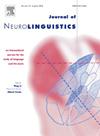The right sound at the right time: Cerebellar and ventral striatal involvement in imitating pitch and timing
IF 1.2
3区 心理学
Q2 LINGUISTICS
引用次数: 0
Abstract
Acting on the world requires the right action at the right time. This is perhaps most easily seen in music where the meaning of a piece is encoded explicitly by both the pitches of musical notes and their duration. We used these features to operationalise the production of desired qualia of movements as note pitches as compared to movement timing as note durations. Participants listened to and imitated simple melodies as accurately as possible while lying in an ultra-high field 7T MRI scanner. Melodies consisted of either a series of different pitches of equal duration or a single pitch repeated at different durations. Both tasks engaged a broad motor network similar to speech and other complex dynamic movements. However, imitation for timing preferentially activated the ventral striatum of the basal ganglia while imitation for pitch preferentially activated lobule VI of the cerebellum and temporal lobe auditory association areas. These findings are consistent with the role of the basal ganglia in sound sequence learning and with the role of the cerebellum in refining movement based on sensory feedback. Imitating melodies provides a simple but effective framework for manipulating the qualities and timings of sound production by the speech-motor system, even when no words are spoken.
在正确的时间发出正确的声音:小脑和腹侧纹状体参与模仿音高和时间
对世界采取行动需要在正确的时间采取正确的行动。这也许在音乐中最容易看到,在音乐中,一个作品的意义是由音符的音高和它们的持续时间明确编码的。我们使用这些特征来操作生产所需的运动音质作为音符音高,而不是作为音符持续时间的运动定时。参与者躺在超高场7T核磁共振扫描仪中,尽可能准确地听和模仿简单的旋律。旋律由一系列相同持续时间的不同音高或以不同持续时间重复的单一音高组成。这两项任务都涉及广泛的运动网络,类似于语言和其他复杂的动态运动。然而,模仿时间优先激活基底节区腹侧纹状体,而模仿音高优先激活小脑第六小叶和颞叶听觉关联区。这些发现与基底神经节在声音序列学习中的作用以及小脑在基于感觉反馈的运动优化中的作用是一致的。模仿旋律提供了一个简单而有效的框架,通过语言运动系统操纵声音产生的质量和时间,即使没有说话。
本文章由计算机程序翻译,如有差异,请以英文原文为准。
求助全文
约1分钟内获得全文
求助全文
来源期刊

Journal of Neurolinguistics
医学-神经科学
CiteScore
3.90
自引率
5.00%
发文量
49
审稿时长
17.2 weeks
期刊介绍:
The Journal of Neurolinguistics is an international forum for the integration of the neurosciences and language sciences. JNL provides for rapid publication of novel, peer-reviewed research into the interaction between language, communication and brain processes. The focus is on rigorous studies of an empirical or theoretical nature and which make an original contribution to our knowledge about the involvement of the nervous system in communication and its breakdowns. Contributions from neurology, communication disorders, linguistics, neuropsychology and cognitive science in general are welcome. Published articles will typically address issues relating some aspect of language or speech function to its neurological substrates with clear theoretical import. Interdisciplinary work on any aspect of the biological foundations of language and its disorders resulting from brain damage is encouraged. Studies of normal subjects, with clear reference to brain functions, are appropriate. Group-studies on well defined samples and case studies with well documented lesion or nervous system dysfunction are acceptable. The journal is open to empirical reports and review articles. Special issues on aspects of the relation between language and the structure and function of the nervous system are also welcome.
 求助内容:
求助内容: 应助结果提醒方式:
应助结果提醒方式:


